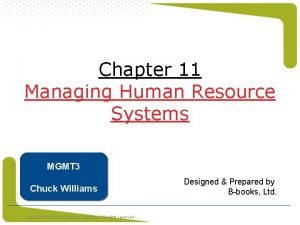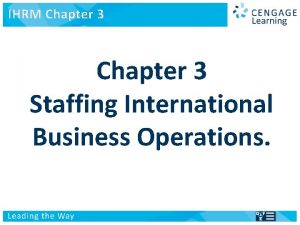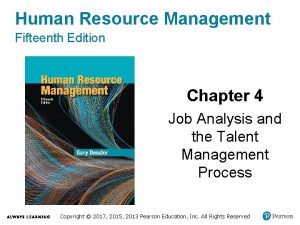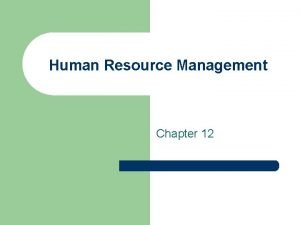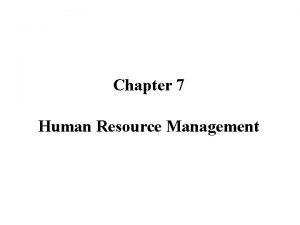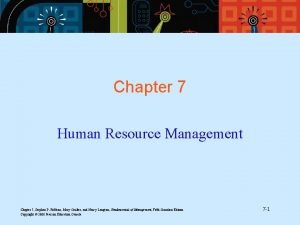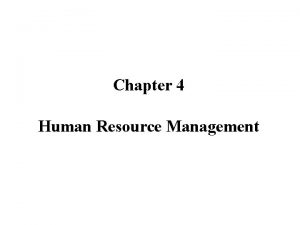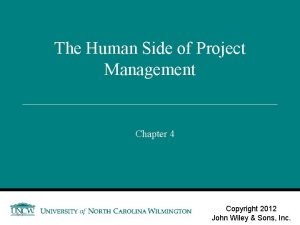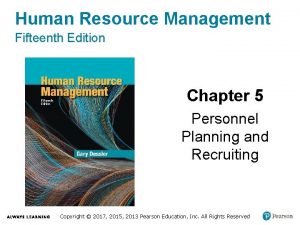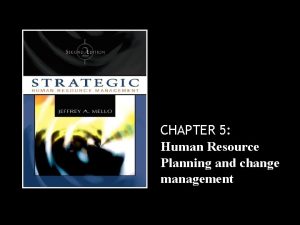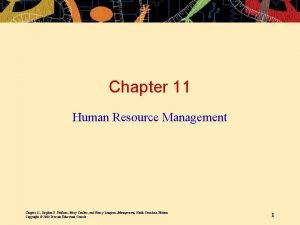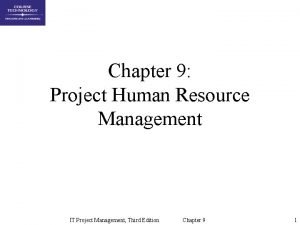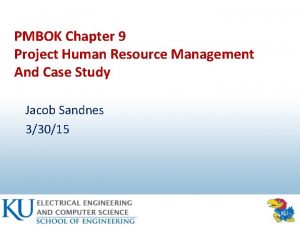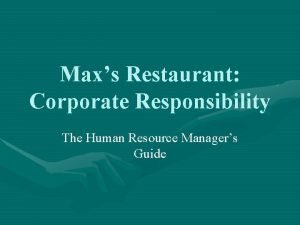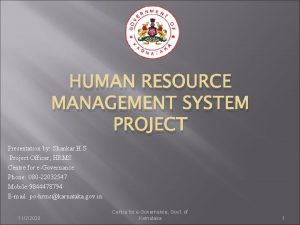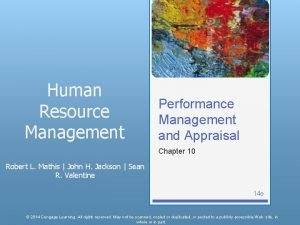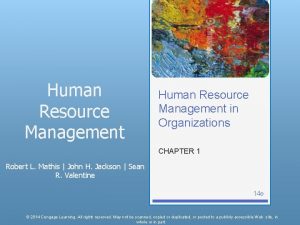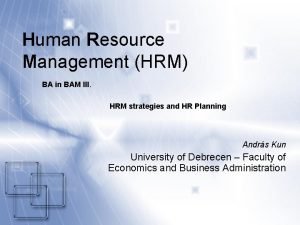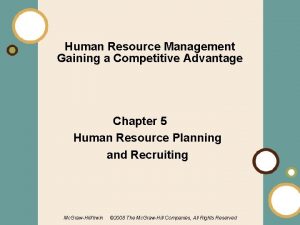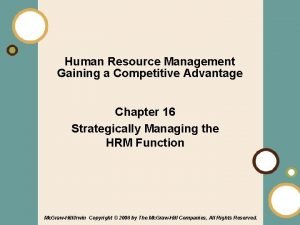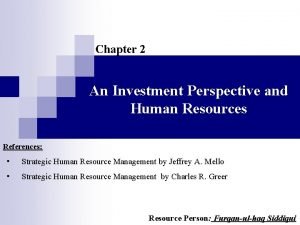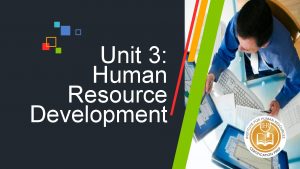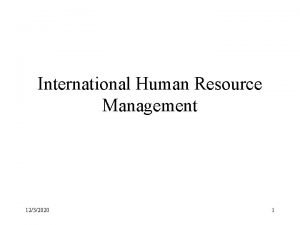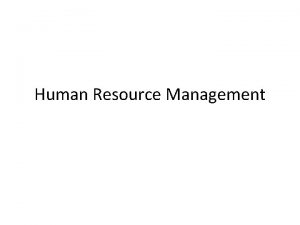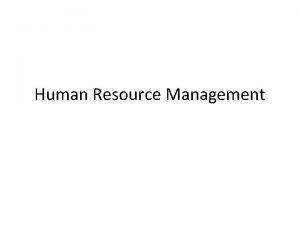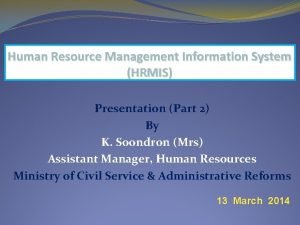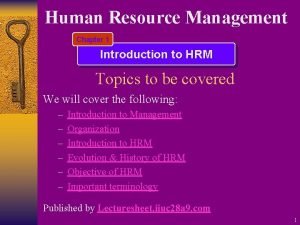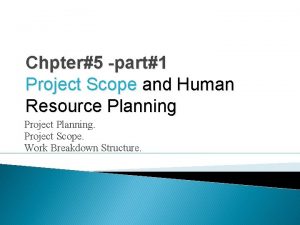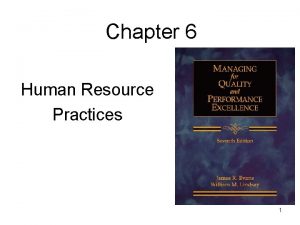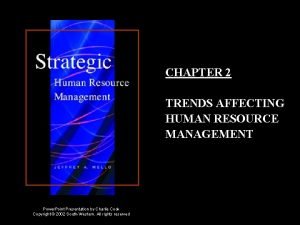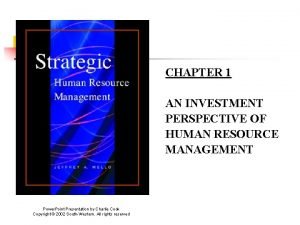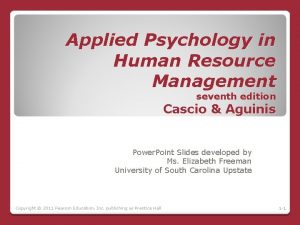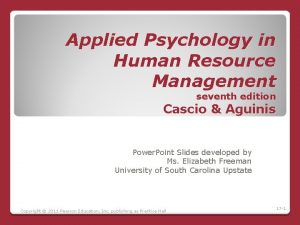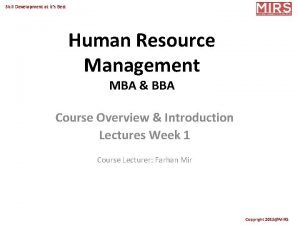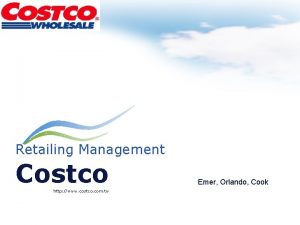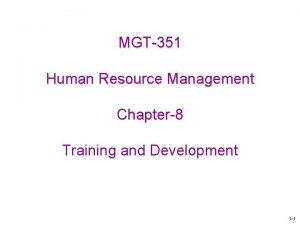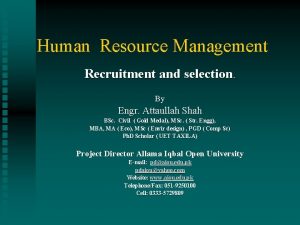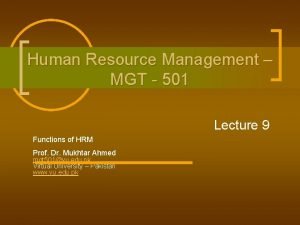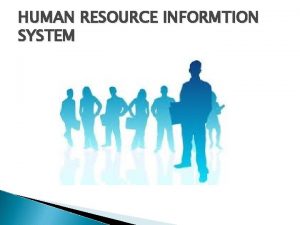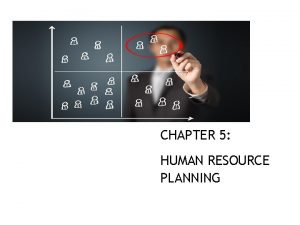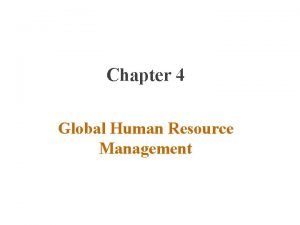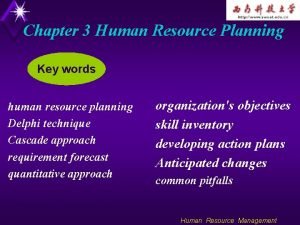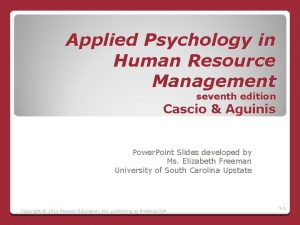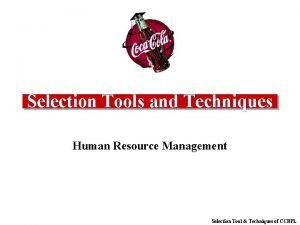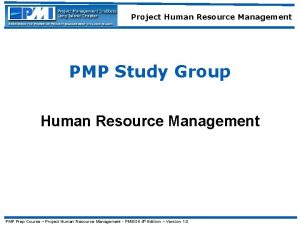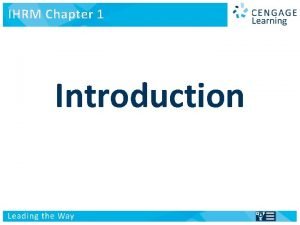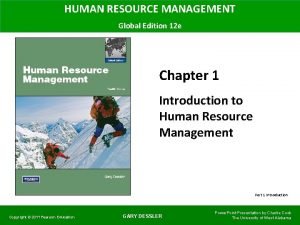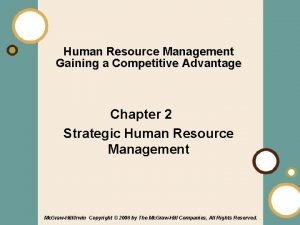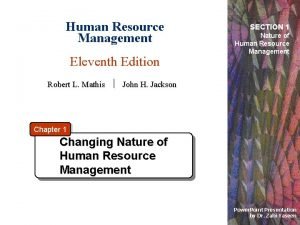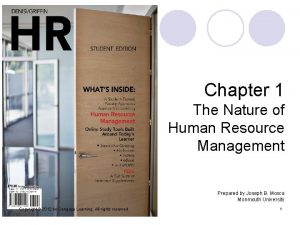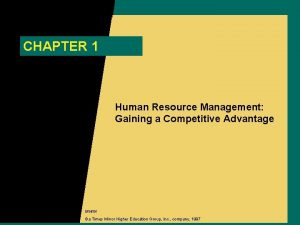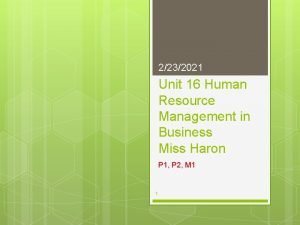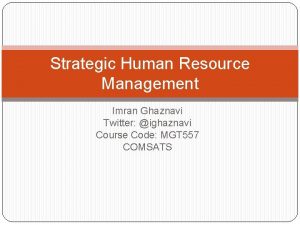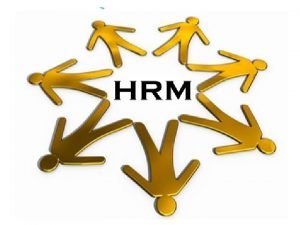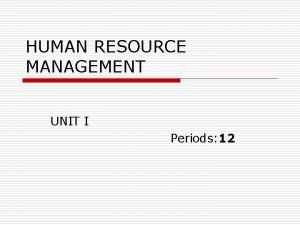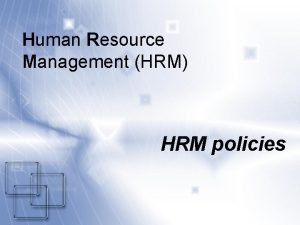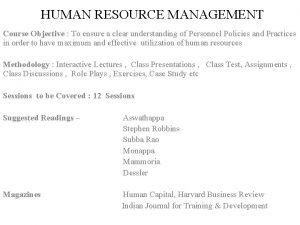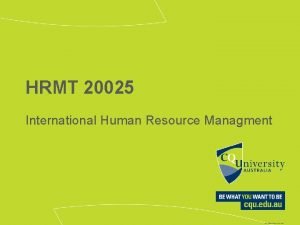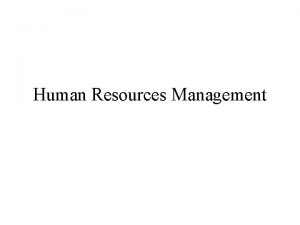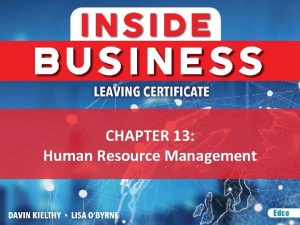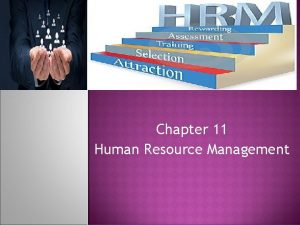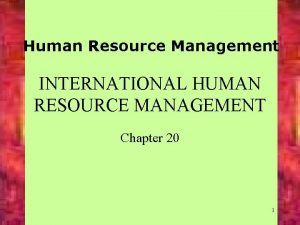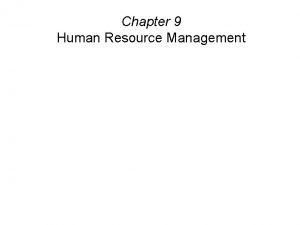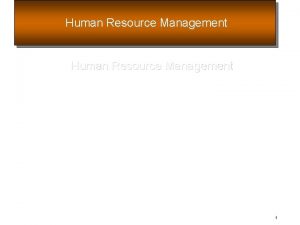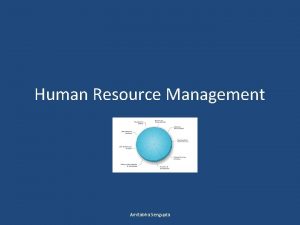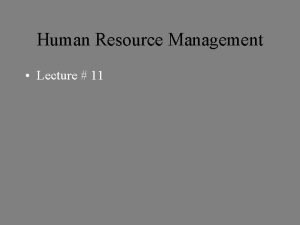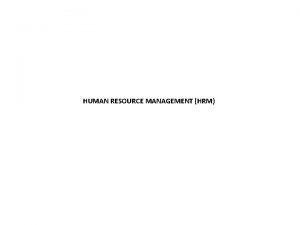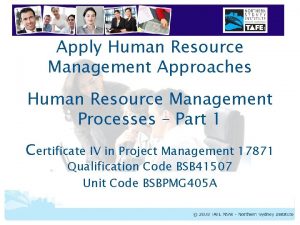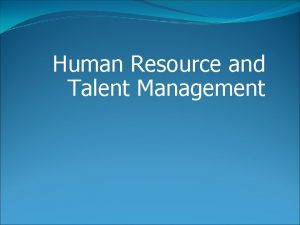Chapter 12 Management of Human Resources Human Resource























































































- Slides: 87

Chapter 12 Management of Human Resources

Human Resource Management (HRM) l Involves an integrative process of recruiting, selecting, training, and maintaining the workforce needed to achieve an organization’s goals. l Necessary to ensure all of the outputs to the system are achieved. © 2004 Pearson Education, Inc. Upper Saddle River, New Jersey 07458 Foodservice Organizations, 5 th edition Spears & Gregoire

Evolution of Human Resource Management l The factory → mass production → HRM l Scientific management – the systematic approach to improving worker efficiency based on the collection and analysis of data. l Began when the human element was added to management functions. © 2004 Pearson Education, Inc. Upper Saddle River, New Jersey 07458 Foodservice Organizations, 5 th edition Spears & Gregoire

Human Resources Planning l Process of anticipating and making provision for the movement of people into, within, & out of an organization. l Use people as effectively as possible. l Have the required number of qualified people available when openings occur. © 2004 Pearson Education, Inc. Upper Saddle River, New Jersey 07458 Foodservice Organizations, 5 th edition Spears & Gregoire

Forecasting Supply and Demand Determine the number, type, & qualifications of individuals who will be needed to perform specific duties at a certain time. l Internal supply of labor – number and type of employees who will be in the operation at some future date. l External supply of labor – number and type of people who will be available for hiring in the labor market. l © 2004 Pearson Education, Inc. Upper Saddle River, New Jersey 07458 Foodservice Organizations, 5 th edition Spears & Gregoire

Supply Analysis l Uses internal and external sources. l Staffing tables – pictorial representation of all jobs with the number of employees in those jobs and future employment requirements. l Skills inventories – contain information on each employee’s education, skills, experience, & career aspirations. © 2004 Pearson Education, Inc. Upper Saddle River, New Jersey 07458 Foodservice Organizations, 5 th edition Spears & Gregoire

Balancing Supply and Demand l Demand – based on forecast l Supply – based on finding employees who have the required qualifications to fill vacancies. l If shortages are predicted: New employees can be hired l Present employees can be retrained l Retiring employees can be asked to stay on l Labor-saving methods can be introduced l © 2004 Pearson Education, Inc. Upper Saddle River, New Jersey 07458 Foodservice Organizations, 5 th edition Spears & Gregoire

Legal Environment l Equal Pay Act 1963 l Title VII of Civil Rights Act 1964 l Age Discrimination in Employment 1967 l Pregnancy Discrimination 1978 l Immigration Reform and Control Act 1986 l Worker Adjustment and Retraining Act 1988 © 2004 Pearson Education, Inc. Upper Saddle River, New Jersey 07458 Foodservice Organizations, 5 th edition Spears & Gregoire

Legal Environment l Americans with Disabilities Act 1990 l Family and Medical Leave Act 1993 l Uniformed Services Employment and Reemployment Rights Act 1994 l Health Insurance Portability and Accountability Act 1996 © 2004 Pearson Education, Inc. Upper Saddle River, New Jersey 07458 Foodservice Organizations, 5 th edition Spears & Gregoire

Sexual Harassment l. A form of gender discrimination. l Violation of Title VII of the Civil Rights Act of 1964. l Forms: Quid pro quo – something for something. Sexual favors for job benefit. l Hostile work environment – workplace is rendered offensive by acts the employer knew or should have known about. l © 2004 Pearson Education, Inc. Upper Saddle River, New Jersey 07458 Foodservice Organizations, 5 th edition Spears & Gregoire

Immigration Reform and Control Act (IRCA) l Unlawful for a person or organization to recruit or hire persons not legally eligible for employment in the US. l Requires employers to complete an I-9 form for each employee. l Prohibits employers of 4 or more persons from discriminating based on national origin or immigration status. © 2004 Pearson Education, Inc. Upper Saddle River, New Jersey 07458 Foodservice Organizations, 5 th edition Spears & Gregoire

Americans with Disabilities Act (ADA) l Purpose: l l Provide a national mandate to eliminate discrimination against individuals with disabilities. Provide consistent enforceable standards for those with disabilities. Ensure the federal government plays a central role in enforcing the standards. Invoke congressional authority to address the major areas of discrimination faced by the disabled. © 2004 Pearson Education, Inc. Upper Saddle River, New Jersey 07458 Foodservice Organizations, 5 th edition Spears & Gregoire

Americans with Disabilities Act (ADA) l Disability: l l l Physical or mental impairment that substantially limits one or more major life activities, such as walking, seeing, hearing, speaking, learning, or working. Record of impairments (such as mental, emotional, or physical illness and alcohol or drug addiction) from which people have recovered or are recovering. Reactions by others implying that people have an impairment, such as severe burns or being rumored to have AIDS. © 2004 Pearson Education, Inc. Upper Saddle River, New Jersey 07458 Foodservice Organizations, 5 th edition Spears & Gregoire

Americans with Disabilities Act (ADA) l Does not require hiring disabled persons who are not qualified for a job in terms of skill, education, or experience. l Requires qualified disabled persons get equal consideration for a job and equal treatment on the job. l Restaurants are the leading industry in employment of people with disabilities. © 2004 Pearson Education, Inc. Upper Saddle River, New Jersey 07458 Foodservice Organizations, 5 th edition Spears & Gregoire

Employment Process l Major phases: Recruitment – Locating and encouraging potential applicants to apply for a job opening. l Selection – Comparing knowledge, skills, and abilities to those required of a position and choosing applicant most qualified. l Orientation – Familiarizing new employees to the organization, job, and work unit. l © 2004 Pearson Education, Inc. Upper Saddle River, New Jersey 07458 Foodservice Organizations, 5 th edition Spears & Gregoire

Recruitment l Process of locating & encouraging potential applicants to apply for a job opening l Vacancy filled by someone inside or outside the organization l Depends on availability of employees, organization’s human resource policies, & requirements of vacant job © 2004 Pearson Education, Inc. Upper Saddle River, New Jersey 07458 Foodservice Organizations, 5 th edition Spears & Gregoire

Selection © 2004 Pearson Education, Inc. Upper Saddle River, New Jersey 07458 Foodservice Organizations, 5 th edition Spears & Gregoire

Application and Screening l Application purposes: Indicates the applicant is interested in a position. l Provides the interviewer with basic information to conduct an interview. l Becomes part of the file if the applicant is hired. l © 2004 Pearson Education, Inc. Upper Saddle River, New Jersey 07458 Foodservice Organizations, 5 th edition Spears & Gregoire

Application and Screening l May not ask questions on an applicant’s: l l l l Age Gender Race Religion National origin Family status May ask question on: l l l Previous experiences Salary expectations Issues related to the job © 2004 Pearson Education, Inc. Upper Saddle River, New Jersey 07458 Foodservice Organizations, 5 th edition Spears & Gregoire

Background and Reference Checks l Most organizations use the mail and telephone to check references. l Supervisors who know the applicant’s work habits and performance usually give the most useful information. l Inadequate reference checking is one of the major causes of high turnover, employee theft, and white-collar crime. © 2004 Pearson Education, Inc. Upper Saddle River, New Jersey 07458 Foodservice Organizations, 5 th edition Spears & Gregoire

Interviews l Structured interview – interviewer asks same specific questions of all interviewees. l Unstructured interview – allows the interviewer the freedom to ask questions he or she believes are important. © 2004 Pearson Education, Inc. Upper Saddle River, New Jersey 07458 Foodservice Organizations, 5 th edition Spears & Gregoire

Effective Interview Tips l l l Establish rapport with the applicant. Allow sufficient time for an uninterrupted interview. Hold interview in a place where privacy is possible. Avoid questions that may be discriminatory. Avoid asking questions that can be “yes” or “no”. © 2004 Pearson Education, Inc. Upper Saddle River, New Jersey 07458 Foodservice Organizations, 5 th edition Spears & Gregoire

Effective Interview Tips l Avoid asking leading questions to which the expected response is obvious. l Allow candidates to express themselves. l Avoid Personal biases – preferences that alter objective decision making. l Avoid halo effect – when a single trait dominates the assessment of another individual. © 2004 Pearson Education, Inc. Upper Saddle River, New Jersey 07458 Foodservice Organizations, 5 th edition Spears & Gregoire

Medical Examination l Not required by all employers. l Give to ensure that the prospective employee is healthy enough to perform the job. l Can be used as a baseline for future examinations. l Drug testing is also becoming more common. © 2004 Pearson Education, Inc. Upper Saddle River, New Jersey 07458 Foodservice Organizations, 5 th edition Spears & Gregoire

Hiring Decision l Most critical step. l Equal employment opportunity – Policy of equal employment (nondiscrimination) for all. l Affirmative action – employees are required to analyze their workforce and develop a plan of action to correct areas of past discrimination. © 2004 Pearson Education, Inc. Upper Saddle River, New Jersey 07458 Foodservice Organizations, 5 th edition Spears & Gregoire

Hiring Decision l The offer confirms: The details of the job. l Working arrangements l Salary or wages l Specifies a time limit in which the applicant must reach a decision. l l Rejected individuals should be notified immediately and given reason for rejection. © 2004 Pearson Education, Inc. Upper Saddle River, New Jersey 07458 Foodservice Organizations, 5 th edition Spears & Gregoire

Affirmative Action Reaffirms the commitment to nondiscrimination and equal employment. l Ensure equal treatment for applicants and employees without regard to race, color, national origin, ancestry, sex, age, religion, or disability. l Goal is to achieve a workforce that includes a representation of qualified minorities, women, and persons with disabilities that approximates their availability in the state resident workforce. l © 2004 Pearson Education, Inc. Upper Saddle River, New Jersey 07458 Foodservice Organizations, 5 th edition Spears & Gregoire

Orientation Designed to provide information new employees need to function comfortably and effectively in the organization. l Includes: l l Review of the organization and how the employee’s job contributes to the organization’s objectives. Specific information on policies, work rules, and benefits. General information about the daily work routine. © 2004 Pearson Education, Inc. Upper Saddle River, New Jersey 07458 Foodservice Organizations, 5 th edition Spears & Gregoire

Orientation l Objectives: Minimize start-up costs to prevent new employees from making costly mistakes. l Reduce anxiety. l Help create realistic job expectations. l Decrease turnover. l Increase job performance. l © 2004 Pearson Education, Inc. Upper Saddle River, New Jersey 07458 Foodservice Organizations, 5 th edition Spears & Gregoire

Training and Development l Training – ongoing process of updating skills of an employee. l Management development – programs designed to improve the technical, human, and conceptual skills of managers. l Both should include carefully formulated objectives, a well-planned outline, and an evaluation. © 2004 Pearson Education, Inc. Upper Saddle River, New Jersey 07458 Foodservice Organizations, 5 th edition Spears & Gregoire

On-the-job Training l Job rotation – employees are assigned to work on a series of jobs over a period of time. l Internship - job training is combined with classroom instruction. l Apprenticeship – employees are assigned to highly skilled coworkers responsible for their training. © 2004 Pearson Education, Inc. Upper Saddle River, New Jersey 07458 Foodservice Organizations, 5 th edition Spears & Gregoire

Off-the-job Training l Takes place outside the workplace. l May include: Simulation of actual working conditions. l Case studies l Role playing l Seminars, lectures, and films l © 2004 Pearson Education, Inc. Upper Saddle River, New Jersey 07458 Foodservice Organizations, 5 th edition Spears & Gregoire

Performance Appraisal Performance – the degree of accomplishment of the tasks that make up an individual’s job. l Objectives: l l l Provide employees with the opportunity to discuss their performance with the supervisor or manager. Identify strengths and weaknesses of the employee’s performance. Suggest ways the employee can meet performance standards, if they have not been met. Provide a basis for future job assignments and salary recommendations. © 2004 Pearson Education, Inc. Upper Saddle River, New Jersey 07458 Foodservice Organizations, 5 th edition Spears & Gregoire

Performance Appraisal Methods l Includes: Checklist – rater does not evaluate performance but merely records it. l Rating scale – rater indicates the degree to which an employee possesses that trait or characteristic on a scale. l Critical incident technique – identifies positive and negative incidents of employee behavior. l © 2004 Pearson Education, Inc. Upper Saddle River, New Jersey 07458 Foodservice Organizations, 5 th edition Spears & Gregoire

Rating Scales l Differences between scales: l l l Characteristics or dimensions on which individuals are rated. Degree to which the performance dimension is defined for the rater. How clearly the points on the scale are defined. Mixed standard scales l Behaviorally anchored rating scale (BARS) l © 2004 Pearson Education, Inc. Upper Saddle River, New Jersey 07458 Foodservice Organizations, 5 th edition Spears & Gregoire

Management by Objectives (MBO) Primarily used with managerial and professional personnel. l Requirements: l l Objectives set at each level should be quantifiable and measurable for both the long and short term. Expected results must be under the employee’s control, and goals must be reviewed and evaluated. Each employee goal statement must be accompanied by a description of how the goal will be accomplished. © 2004 Pearson Education, Inc. Upper Saddle River, New Jersey 07458 Foodservice Organizations, 5 th edition Spears & Gregoire

360º Review l Type of performance review l involves obtaining evaluation feedback from superiors, subordinates, and peers. © 2004 Pearson Education, Inc. Upper Saddle River, New Jersey 07458 Foodservice Organizations, 5 th edition Spears & Gregoire

Appraisal Interviews Opportunity to discuss an employee’s performance and explore areas of improvement. l Recommendations: l l l Emphasize strengths on which the individual can build rather than stress weaknesses. Avoid recommendations about changing personal traits. Concentrate on opportunities for growth. Limit plans for change or growth to a few objectives that can be accomplished within a reasonable period of time. © 2004 Pearson Education, Inc. Upper Saddle River, New Jersey 07458 Foodservice Organizations, 5 th edition Spears & Gregoire

Personnel Actions l Includes: Promotion – change in job to one at a higher level in the organization. l Demotion – change in job to one at a lower level in the organization. l Transfer – change in job to one at approximately the same level elsewhere in the organization. l Separation – Voluntary or involuntary termination of a job l © 2004 Pearson Education, Inc. Upper Saddle River, New Jersey 07458 Foodservice Organizations, 5 th edition Spears & Gregoire

Employee Discipline – action against an employee who fails to conform to the policies or rules of an organization. l Disciplinary Procedures l l l l Unrecorded oral warning Oral warning with notation in an employee’s personnel file Written reprimand Suspension Discharge Consistency is a key element. © 2004 Pearson Education, Inc. Upper Saddle River, New Jersey 07458 Foodservice Organizations, 5 th edition Spears & Gregoire

Grievance Procedures l Ensures employees have due process in disciplinary situations. l Grievance reduction methods: Accurate job descriptions and specifications l Individuals have appropriate qualifications for job requirements l Effective orientation, training, and performance evaluation systems l Good human skills by supervisors l © 2004 Pearson Education, Inc. Upper Saddle River, New Jersey 07458 Foodservice Organizations, 5 th edition Spears & Gregoire

Identifying Causes Must first consider if employee is aware of certain policies and work rules before initiating disciplinary action l Health problems, personal crises, emotional problems, stress, or chemical dependency may be source of unsatisfactory performance l Employee assistance program – provides diagnoses, counseling, & referral for advice or treatment for problems l © 2004 Pearson Education, Inc. Upper Saddle River, New Jersey 07458 Foodservice Organizations, 5 th edition Spears & Gregoire

Compensation l Financial remuneration by employers to employees in exchange for their work. l Includes: Salary – refers to the earnings of managerial and professional personnel. l Wages – hourly earnings of employees covered by the Fair Labor Standards Act. l Benefits – rewards that provide security to employees and their family members. l © 2004 Pearson Education, Inc. Upper Saddle River, New Jersey 07458 Foodservice Organizations, 5 th edition Spears & Gregoire

Wage Mix l Combination of external and internal factors that can influence rates at which employees are paid. © 2004 Pearson Education, Inc. Upper Saddle River, New Jersey 07458 Foodservice Organizations, 5 th edition Spears & Gregoire

External Factors l Include: l l l Labor market conditions Geographic area Cost of living Collective bargaining Government influence Consumer price index – measure of the average change in prices over time in a fixed market basket of products and services. © 2004 Pearson Education, Inc. Upper Saddle River, New Jersey 07458 Foodservice Organizations, 5 th edition Spears & Gregoire

Internal Factors l Include: Worth of job l Employees’ relative worth – employees who possess the same qualifications should receive the same pay. l Employer’s ability to pay – willingness of the taxpayer to provide funds in the public sector or by the profits from products and service in the private sector. l © 2004 Pearson Education, Inc. Upper Saddle River, New Jersey 07458 Foodservice Organizations, 5 th edition Spears & Gregoire

Job Evaluation l Process of determining the relative worth of jobs to establish which jobs should be paid more than others. l Methods: Job ranking – groups jobs on the basis of their relative worth from most to least complex. l Job classification – groups jobs according to a series of predetermined wage classes or grades. l © 2004 Pearson Education, Inc. Upper Saddle River, New Jersey 07458 Foodservice Organizations, 5 th edition Spears & Gregoire

Benefits Noncash rewards given to employees by their employer as part of their employment. l Categories: l l l l Legally required benefits Health insurance Retirement Insurance Paid time off (PTO) Employee services © 2004 Pearson Education, Inc. Upper Saddle River, New Jersey 07458 Foodservice Organizations, 5 th edition Spears & Gregoire

Flexible Benefit Packages Modular plans – allow the employee to select from among a list of benefits or different levels of benefits. l Core-plus plans – consist of a core of essential benefits all employees receive and an array of benefit options employees can select. l Flexible spending accounts – employees can deposit pre-tax dollars to use to pay for items such as child care and medical care. l © 2004 Pearson Education, Inc. Upper Saddle River, New Jersey 07458 Foodservice Organizations, 5 th edition Spears & Gregoire

Compensation Regulations l Fair Labor Standards Act (FLSA) – concerned with minimum wage rates, overtime payments, child labor, and equal rights. l Equal Pay Act of 1963 – prohibits discrimination of women. l Age Discrimination Act of 1967 – prohibits discrimination of employees over the age of 40. © 2004 Pearson Education, Inc. Upper Saddle River, New Jersey 07458 Foodservice Organizations, 5 th edition Spears & Gregoire

Benefits Regulations Social Security Act of 1935 – protects covered employees against loss of earnings resulting from retirement, unemployment, disability, or death. l Compensatory benefits: l l l l Vacation Sick leave Holidays Military Jury duty Absences due to a death in the family © 2004 Pearson Education, Inc. Upper Saddle River, New Jersey 07458 Foodservice Organizations, 5 th edition Spears & Gregoire

Labor Relations l Interaction between management and labor union. l Collective bargaining – negotiation between management and the union on terms of the collective agreement between them. © 2004 Pearson Education, Inc. Upper Saddle River, New Jersey 07458 Foodservice Organizations, 5 th edition Spears & Gregoire

Reasons for Joining Unions l Labor unions have developed as a reaction to management’s decisionmaking power. l Employees join unions because of: Economic needs l General dissatisfaction with management policies l Social needs l Employment in an union shop. l © 2004 Pearson Education, Inc. Upper Saddle River, New Jersey 07458 Foodservice Organizations, 5 th edition Spears & Gregoire

Structure and Functions of Unions l Functions of unions: Govern entry to an occupation l Define standards of occupational conduct l Regulate employment l l Union levels: AFL-CIO l National and international unions l Local unions belonging to a parent national union. l © 2004 Pearson Education, Inc. Upper Saddle River, New Jersey 07458 Foodservice Organizations, 5 th edition Spears & Gregoire

AFL-CIO l l American Federation of Labor (AFL) Congress of Industrial Organizations (CIO) Includes 75% of all union members Federation of 83 autonomous national and international unions that: l l Lobbies before legislative bodies on subjects of interest to labor. Coordinates organizing efforts among its affiliated unions. Publicizes concerns and benefits of unionization to the public. Resolves disputes between different unions. © 2004 Pearson Education, Inc. Upper Saddle River, New Jersey 07458 Foodservice Organizations, 5 th edition Spears & Gregoire

National and International Unions International unions organize employees and charters local unions in foreign countries. l National unions provide: l l l Technical assistance in negotiating and administering labor contracts Financial assistance during strikes Administration of union-sponsored pension plans and other fringe benefits Training programs for local union officers Publications © 2004 Pearson Education, Inc. Upper Saddle River, New Jersey 07458 Foodservice Organizations, 5 th edition Spears & Gregoire

Local Unions Responsible for negotiating local labor agreements and investigating member grievances. l Union steward – union employee who is elected to represent other union members in their relations with an immediate supervisor or other managers. l Business representative – hired by the local union to manage the union and also to settle a member’s grievance if the steward was not successful. l © 2004 Pearson Education, Inc. Upper Saddle River, New Jersey 07458 Foodservice Organizations, 5 th edition Spears & Gregoire

Foodservice Unions l Hotel and Restaurant Employees Union l United Food and Commercial Workers Union l Service Employees International Union © 2004 Pearson Education, Inc. Upper Saddle River, New Jersey 07458 Foodservice Organizations, 5 th edition Spears & Gregoire

Norris-La. Guardia Act l Anti-Injunction Act l Restricts employers ability to obtain a federal injunction forbidding a union from engaging in picketing or strike activities. l Nullified yellow-dog contracts – agreements that required workers to state they were not union members and promise not to join one. © 2004 Pearson Education, Inc. Upper Saddle River, New Jersey 07458 Foodservice Organizations, 5 th edition Spears & Gregoire

Wagner Act Protected employee efforts to organize and bargain collectively through representatives of their choice. l Established the right of a union to be the exclusive bargaining agent for all workers in a bargaining unit. l Bargaining unit – group of jobs in a firm, plant, or industry with sufficient commonality to constitute an entity that can be represented in union negotiations by a particular agent. l © 2004 Pearson Education, Inc. Upper Saddle River, New Jersey 07458 Foodservice Organizations, 5 th edition Spears & Gregoire

Wagner Act l Unfair labor practices: l l l Management support of a company union Discharge or discipline of workers for union activities Discrimination against workers making complaints to the National Labor Relations Board (NLRB). Refusal to bargain with employee representatives Interference with the rights of employees to act together for mutual aid or protection © 2004 Pearson Education, Inc. Upper Saddle River, New Jersey 07458 Foodservice Organizations, 5 th edition Spears & Gregoire

Taft-Hartley Act l Balanced the powers of labor and management. l Placed restraints on union practices. l Required 30 days notice before terminating a labor agreement (90 days for healthcare). © 2004 Pearson Education, Inc. Upper Saddle River, New Jersey 07458 Foodservice Organizations, 5 th edition Spears & Gregoire

Taft-Hartley Act l Unfair union practices: l l l l Restraining or coercing employers in the selection of parties to bargain on their behalf Persuading employers to discriminate against any employees Refusing to bargain collectively Participating in secondary boycotts and jurisdictional disputes Attempting to force recognition from an employer when another union is already the representative Charging excessive initiation fees Requiring payment for services not performed © 2004 Pearson Education, Inc. Upper Saddle River, New Jersey 07458 Foodservice Organizations, 5 th edition Spears & Gregoire

Landrum-Griffin Act Labor-Management Reporting and Disclosure Act l Required: l l l Labor organizations to hold periodic elections for officers Members be entitled to due process both within and outside the union Copies of labor agreements be made available to covered employees Financial dealings between union officials and companies be disclosed to the U. S. Department of Labor. © 2004 Pearson Education, Inc. Upper Saddle River, New Jersey 07458 Foodservice Organizations, 5 th edition Spears & Gregoire

Contract Negotiations l Major bargaining issues: Economic issues – base pay, shift differentials, overtime pay, length of service increases, cost of living allowances, pension plans, insurance, holidays, and vacations. l Job security – entitlement to work or, in lieu of work, to income protection. l Working conditions – work rules, relief periods, work schedules, and health and safety. l © 2004 Pearson Education, Inc. Upper Saddle River, New Jersey 07458 Foodservice Organizations, 5 th edition Spears & Gregoire

Contract Negotiations l Major bargaining issues: Management rights – rights of management to give direction and discipline employees. l Individual rights – establishment of employee grievance procedures. l © 2004 Pearson Education, Inc. Upper Saddle River, New Jersey 07458 Foodservice Organizations, 5 th edition Spears & Gregoire

Contract Negotiations l If a deadlock occurs, a third party may be called in to provide assistance. Mediator – attempts to establish a channel of communication between the union and management but has no power to force a settlement. l Arbitrator – renders a decision that is binding on both the union and the employer. l © 2004 Pearson Education, Inc. Upper Saddle River, New Jersey 07458 Foodservice Organizations, 5 th edition Spears & Gregoire

Controlling Labor Costs l Approaches to control labor costs: Increase use of convenience foods l Decrease number of items on a menu l Improve efficiency of facility layout l Improve efficiency of equipment l Increase employee benefits l © 2004 Pearson Education, Inc. Upper Saddle River, New Jersey 07458 Foodservice Organizations, 5 th edition Spears & Gregoire

Controlling Labor Costs l Factors to control labor costs: Personnel policies l Job analysis l Work simplification l Work production standards l Workload forecasting l Scheduling l Control reports l © 2004 Pearson Education, Inc. Upper Saddle River, New Jersey 07458 Foodservice Organizations, 5 th edition Spears & Gregoire

Foodservice Labor Force l Typical foodservice employee is: Female (57%) l Under 30 years old l Single (never married, divorced, or widowed) l Living in a household with two or more wage earners l A part-time employee with weekly hours averaging 25. 2 l © 2004 Pearson Education, Inc. Upper Saddle River, New Jersey 07458 Foodservice Organizations, 5 th edition Spears & Gregoire

Staffing and Scheduling l Staffing – management function that determines the appropriate number of employees needed by the organization for the work that must be accomplished. l Scheduling – assigning employees to specific work hours and days. © 2004 Pearson Education, Inc. Upper Saddle River, New Jersey 07458 Foodservice Organizations, 5 th edition Spears & Gregoire

Staffing and Scheduling Variables l Operational l Staffing & scheduling extremely complex because of highly variable nature of business l Types l Differences of Foodservice Major determinant of staffing needs in operation © 2004 Pearson Education, Inc. Upper Saddle River, New Jersey 07458 Foodservice Organizations, 5 th edition Spears & Gregoire

Relief Employees l Part-Time employees Work less than 35 -40 hours/week l May not be eligible for benefits l Split-shift scheduling – employees are scheduled to work during peak hours only. l l Temporary employees (temps) Fill short-term staffing needs l Hired from professional temporary employment agencies l © 2004 Pearson Education, Inc. Upper Saddle River, New Jersey 07458 Foodservice Organizations, 5 th edition Spears & Gregoire

Relief Employees l Leased employees Employees are leased from a employment leasing company for specified period of time at a specified fee. l Leasing company handles employee-related benefits, payment etc. l © 2004 Pearson Education, Inc. Upper Saddle River, New Jersey 07458 Foodservice Organizations, 5 th edition Spears & Gregoire

Staffing l Productivity Levels – meals per labor hour. l Full-time equivalents (FTEs)- number of total hours worked in a week divided by 40 to determine the number of full-time equivalent employees. l Meal equivalent – conversion of number of snacks, nourishment, paid meals, into a common number of meals. © 2004 Pearson Education, Inc. Upper Saddle River, New Jersey 07458 Foodservice Organizations, 5 th edition Spears & Gregoire

Employee Scheduling Master schedule – shows days on and off duty and vacations. l Shift schedule – indicates the position and hours worked, the number of days worked per week, and lists relief assignments for positions when regular workers are off. l Production schedule- identifies tasks to be completed for the production of a meal. l © 2004 Pearson Education, Inc. Upper Saddle River, New Jersey 07458 Foodservice Organizations, 5 th edition Spears & Gregoire

Overtime l Uncontrolled overtime is a key factor in driving up labor cost. l Reasons for overtime: Employees may need to work beyond their normal hours. l Supervisors may use as a substitute for proper scheduling and planning. l l May be controlled by requiring overtime authorization. © 2004 Pearson Education, Inc. Upper Saddle River, New Jersey 07458 Foodservice Organizations, 5 th edition Spears & Gregoire

Alternate Work Schedules l Compressed workweek Holding total hours constant but reduces the number of days worked (4 -day week/10 hours/day). l Change in hours worked, but not the number of days. l Change in days and hours worked. l © 2004 Pearson Education, Inc. Upper Saddle River, New Jersey 07458 Foodservice Organizations, 5 th edition Spears & Gregoire

Alternate Work Schedules l Discretionary working time/flex-time Staggered start – organization or employee choose when they wish to start a fixed-hour working day. l Flex time – organization defines a range of hours within which employees may select their starting time. l Task contracting- employee contracts to fulfill a defined task or piece of work. l © 2004 Pearson Education, Inc. Upper Saddle River, New Jersey 07458 Foodservice Organizations, 5 th edition Spears & Gregoire

Alternate Work Schedules l Part-time employment Job sharing – a single job is divided and shared between two or more employees. l Job splitting – tasks that constitute a single job are divided, with subsets of differentiated tasks assigned to two or more employees. l © 2004 Pearson Education, Inc. Upper Saddle River, New Jersey 07458 Foodservice Organizations, 5 th edition Spears & Gregoire

Productivity Improvement l Productivity – the efficient use of human, equipment, and financial resources, and often is expressed mathematically as a ratio of output to input. l Improvement methods: Productivity methods l Principles of work design l Work measurement l Use of quality improvement teams l © 2004 Pearson Education, Inc. Upper Saddle River, New Jersey 07458 Foodservice Organizations, 5 th edition Spears & Gregoire

Productivity Measures l Use of formulas to measure productivity. © 2004 Pearson Education, Inc. Upper Saddle River, New Jersey 07458 Foodservice Organizations, 5 th edition Spears & Gregoire

Principles of Work Design Work design – program of continuing effort to increase the effectiveness of work systems. l Labor inefficiency factors: l l l l l Poor product design Work methods and Carelessness Management Workers Material waste Improper tools and Inadequate maintenance Poor production scheduling Absences without cause © 2004 Pearson Education, Inc. Upper Saddle River, New Jersey 07458 Foodservice Organizations, 5 th edition Spears & Gregoire

Principles of Work Design l Materials handling – the movement and storage of materials and products as they proceed through the foodservice system. l Principles of motion economy – relates to the design of work methods, of the workplace, and of tools and equipment. © 2004 Pearson Education, Inc. Upper Saddle River, New Jersey 07458 Foodservice Organizations, 5 th edition Spears & Gregoire

Work Measurement in Foodservice Work measurement – relationship between the amount of work performed and the human input used to do that work. l Activity analysis – continuous observation for a chronological record of the nature of activities performed by individual workers, work performed at one workstation, work units produced, or the amount of time that equipment is used and for what purpose. l © 2004 Pearson Education, Inc. Upper Saddle River, New Jersey 07458 Foodservice Organizations, 5 th edition Spears & Gregoire

Work Measurement in Foodservice Employee time log reporting system – technique involving employees recording activities at periodic intervals, usually between 5 and 15 minutes. l Occurrence sampling- a method for measuring working time and nonworking time of people employed in direct and indirect activities. l Elemental standard data – time values that have been determined for many elements and motions common to a wide variety of work. l © 2004 Pearson Education, Inc. Upper Saddle River, New Jersey 07458 Foodservice Organizations, 5 th edition Spears & Gregoire

Work Measurement in Foodservice l Predetermined motion time – tasks are broken down into basic motions with known normal time values. l Master standard data (MSD)- seven basic elements of work are combined into larger, more condensed elements. © 2004 Pearson Education, Inc. Upper Saddle River, New Jersey 07458 Foodservice Organizations, 5 th edition Spears & Gregoire
 Time management in human resource management
Time management in human resource management Assess human resource requirements of a retail organization
Assess human resource requirements of a retail organization Hrm vs hrd
Hrm vs hrd Chapter 2 human resource management
Chapter 2 human resource management Chapter 9 human resource management
Chapter 9 human resource management Chapter 11 human resource management
Chapter 11 human resource management New approaches to organizing hr
New approaches to organizing hr Intro to human resource management
Intro to human resource management Management fifteenth edition
Management fifteenth edition Human resource management lecture chapter 1
Human resource management lecture chapter 1 Types of expatriates in ihrm
Types of expatriates in ihrm Human resource management chapter 4
Human resource management chapter 4 Functions of hrm
Functions of hrm Chapter 7 human resource management
Chapter 7 human resource management Chapter 7 human resource management
Chapter 7 human resource management Human resource management chapter 4
Human resource management chapter 4 Human resource management chapter 4
Human resource management chapter 4 Replacement chart example
Replacement chart example Human resource management chapter 5
Human resource management chapter 5 Chapter 11 human resource management
Chapter 11 human resource management Chapter 9 human resources management
Chapter 9 human resources management Resource management pmp
Resource management pmp Resource management pmbok
Resource management pmbok Human resource management why is it important
Human resource management why is it important Recruitment process of max's restaurant
Recruitment process of max's restaurant Purpose of induction
Purpose of induction Hrms shanker group
Hrms shanker group Mbo performance appraisal method
Mbo performance appraisal method Current issues in human resource management
Current issues in human resource management Ba human resource management
Ba human resource management Higher business management
Higher business management Human resource management gaining a competitive advantage
Human resource management gaining a competitive advantage Downsizing
Downsizing Human resource management gaining a competitive advantage
Human resource management gaining a competitive advantage Exam questions on personnel management
Exam questions on personnel management Performance appraisal in human resource management
Performance appraisal in human resource management Gary dessler human resource management
Gary dessler human resource management Strategic human resource
Strategic human resource Investment perspective of hr
Investment perspective of hr Applied psychology in human resource management
Applied psychology in human resource management Intro to human resource management
Intro to human resource management Unit 3 human resource management
Unit 3 human resource management Separation in hrm
Separation in hrm Human resources and job design in operations management
Human resources and job design in operations management Define human resources management
Define human resources management Weiterbildung human resources management
Weiterbildung human resources management Human resource management syllabus harvard
Human resource management syllabus harvard 5p model of hrm
5p model of hrm What is hrmis system
What is hrmis system What is decruitment
What is decruitment Concept of hrm
Concept of hrm Human resource management laura portolese
Human resource management laura portolese Scope of human resource planning
Scope of human resource planning Human resource management of toyota
Human resource management of toyota International human resource management dowling 6th edition
International human resource management dowling 6th edition Factors affecting human resource management
Factors affecting human resource management An investment perspective of human resource management
An investment perspective of human resource management The role of psychology in human resources management
The role of psychology in human resources management Applied psychology in human resource management
Applied psychology in human resource management Payroll cycle activities
Payroll cycle activities Retrenchment in human resource management
Retrenchment in human resource management Human resource management skills
Human resource management skills Costco store layout strategy
Costco store layout strategy Methods of training in human resource management
Methods of training in human resource management Selection in human resource management
Selection in human resource management Mgt501 human resource management
Mgt501 human resource management Interview in human resource management
Interview in human resource management System defintion
System defintion Factors affecting human resource planning
Factors affecting human resource planning Unit forecasting in hrm
Unit forecasting in hrm Polycentric hr
Polycentric hr Cascade approach in human resource management
Cascade approach in human resource management Applied psychology in human resource management
Applied psychology in human resource management Types of selection tools in hrm
Types of selection tools in hrm What are physical resources
What are physical resources Laurent s-step-5 for true ihrm
Laurent s-step-5 for true ihrm Globalization and competition trends in hrm
Globalization and competition trends in hrm Human resource management gaining a competitive advantage
Human resource management gaining a competitive advantage Can we
Can we Nature of hrm
Nature of hrm One way linkage hrm
One way linkage hrm Unit 16 human resource management
Unit 16 human resource management Explain the concept of human resource management
Explain the concept of human resource management Nature of hrm
Nature of hrm Hr policy meaning
Hr policy meaning Human resource policy
Human resource policy Human resource management course objectives
Human resource management course objectives International resource services
International resource services





